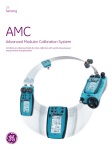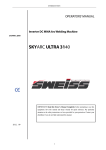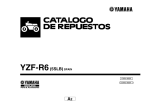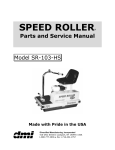Download Furnace Gas - GE Measurement & Control
Transcript
GE Infrastructure Sensing Furnace Gas Sample System User ’s Manual GE Infrastructure Sensing Furnace Gas Sample System User ’s Manual 910-165B1 August 2004 August 2004 Warranty Each instrument manufactured by GE Infrastructure Sensing is warranted to be free from defects in material and workmanship. Liability under this warranty is limited to restoring the instrument to normal operation or replacing the instrument, at the sole discretion of GE Infrastructure Sensing. Fuses and batteries are specifically excluded from any liability. This warranty is effective from the date of delivery to the original purchaser. If GE Infrastructure Sensing determines that the equipment was defective, the warranty period is: • one year for general electronic failures of the instrument • one year for mechanical failures of the sensor If GE Infrastructure Sensing determines that the equipment was damaged by misuse, improper installation, the use of unauthorized replacement parts, or operating conditions outside the guidelines specified by GE Infrastructure Sensing, the repairs are not covered under this warranty. The warranties set forth herein are exclusive and are in lieu of all other warranties whether statutory, express or implied (including warranties or merchantability and fitness for a particular purpose, and warranties arising from course of dealing or usage or trade). Return Policy If a GE Infrastructure Sensing instrument malfunctions within the warranty period, the following procedure must be completed: 1. Notify GE Infrastructure Sensing, giving full details of the problem, and provide the model number and serial number of the instrument. If the nature of the problem indicates the need for factory service, GE Infrastructure Sensing will issue a RETURN AUTHORIZATION number (RA), and shipping instructions for the return of the instrument to a service center will be provided. 2. If GE Infrastructure Sensing instructs you to send your instrument to a service center, it must be shipped prepaid to the authorized repair station indicated in the shipping instructions. 3. Upon receipt, GE Infrastructure Sensing will evaluate the instrument to determine the cause of the malfunction. Then, one of the following courses of action will then be taken: • If the damage is covered under the terms of the warranty, the instrument will be repaired at no cost to the owner and returned. • If GE Infrastructure Sensing determines that the damage is not covered under the terms of the warranty, or if the warranty has expired, an estimate for the cost of the repairs at standard rates will be provided. Upon receipt of the owner’s approval to proceed, the instrument will be repaired and returned. iii August 2004 Table of Contents Introduction . . . . . . . . . . . . . . . . . . . . . . . . . . . . . . . . . . . . . . . . . . . . . . . . . . . . . . . . . . . . . . . . . . . . . . 1 System Design . . . . . . . . . . . . . . . . . . . . . . . . . . . . . . . . . . . . . . . . . . . . . . . . . . . . . . . . . . . . . . . . . . . . 2 Option. . . . . . . . . . . . . . . . . . . . . . . . . . . . . . . . . . . . . . . . . . . . . . . . . . . . . . . . . . . . . . . . . . . . . . . . . . . 3 Installation . . . . . . . . . . . . . . . . . . . . . . . . . . . . . . . . . . . . . . . . . . . . . . . . . . . . . . . . . . . . . . . . . . . . . . . 3 Operation . . . . . . . . . . . . . . . . . . . . . . . . . . . . . . . . . . . . . . . . . . . . . . . . . . . . . . . . . . . . . . . . . . . . . . . . 6 Startup . . . . . . . . . . . . . . . . . . . . . . . . . . . . . . . . . . . . . . . . . . . . . . . . . . . . . . . . . . . . . . . . . . . . . . . 6 Shutdown . . . . . . . . . . . . . . . . . . . . . . . . . . . . . . . . . . . . . . . . . . . . . . . . . . . . . . . . . . . . . . . . . . . . . 7 Maintenance . . . . . . . . . . . . . . . . . . . . . . . . . . . . . . . . . . . . . . . . . . . . . . . . . . . . . . . . . . . . . . . . . . . . . . 7 Cleaning the Moisture Probe . . . . . . . . . . . . . . . . . . . . . . . . . . . . . . . . . . . . . . . . . . . . . . . . . . . . . . . . . 8 Furnace Gas Sample System v August 2004 Introduction Furnace gas is typically comprised of hydrogen, nitrogen, and/or other select dry gases at temperatures which exceed 400°C (700°F). These gases contain significant amounts of metallic particles or vapors. The maximum allowable temperature of the aluminum oxide probe is 70°C (158°F); therefore, a sample gas stream must be removed from the furnace and cooled before a moisture measurement can be taken. During such cooling, metal vapors sublime to form submicron-sized metallic particles. Without proper filtration, these particles can deposit in the aluminum oxide layer of the moisture probe. Metallic deposition will cause a permanent change in calibration and, if allowed to continue, will result in permanent damage to the moisture probe. The oil bath filter is an effective method of removing submicron, solid, metallic particles from a gas stream. As the gas bubbles travel upward through the oil, solid particles are attracted to the liquid surface and become permanently trapped at the liquid-vapor interface. The end result is a clean gas exiting the top of the oil bath filter. When equilibrium conditions exist, the oil will neither remove nor add water to the sample gas. Therefore, the oil bath filter will not affect the moisture measurement. SAMPLE INLET NEEDLE VALVE FILTER SAMPLE CELL OIL BATH FILTER NEEDLE VALVE SAMPLE OUTLET SAMPLE PUMP Figure 1: Flow Diagram (#732-962FD) Furnace Gas Sample System 1 August 2004 System Design Since the gas pressure in most furnaces is low (less than 1/2 psig), the sample must be drawn through the sample system by a vacuum pump. The standard Furnace Gas Sample System is illustrated in Figure 3 on page 4. Your sample system may be slightly different depending on the options that were ordered. The gases are drawn into the sample system through the inlet needle valve (Sample Inlet), into the polyethylene oil bath filter (item 2). The gas will then pass through a 7 micron, sintered, stainless steel filter (item 3) before reaching the sample cell (item 4), which houses the moisture probe. The gas flows through the sample cell and the outlet needle valve to the vacuum pump (item 5) before exiting the sample system. The standard Furnace Gas Sample System has two filters; an oil bath filter (item 2) and a 7 micron, sintered, stainless steel filter (item 3). The function of the oil bath filter is to remove all solid particles from the gas. See Figure 2 below for a detailed drawing of the polyethylene oil bath filter. The gas is drawn to the bottom of the filter column through Tygon tubing, and then bubbled through a saturator stone. The gas bubbles rise through the oil and exit out the top of the filter column. This filter is designed for low pressure (less than 25 psig) and wet dew points (greater than -40°C). The 7-micron, sintered, stainless steel filter will trap oil droplets escaping from the oil bath filter, allowing only the gas to reach the moisture sensor. Union 1/4" SS Tubing Male Compression Fitting (bore through) Sample Inlet Sample Outlet Male Compression Fitting Threaded Aluminum Cap 6061-T6 Polyethylene Graduated Cylinder 250 ml Tygon Tubing Saturator Stone Figure 2: Polyethylene Oil Bath Filter (#750-290) 2 Furnace Gas Sample System August 2004 Option Installation The standard oil bath filter is constructed of polyethylene (PN 080A) and is not suitable for high pressure or for very dry gas. At moisture levels dryer than -40°C frost point, permeation of ambient moisture through the polyethylene can cause significant errors in the moisture measurement. For such dry applications, the stainless steel oil bath filter (PN 080B) is recommended. 1. 2. 3. 4. 5. Using the mounting holes provided, secure the sample system mounting plate (item 6) in a weather-protected location as close to the sample point as possible, preferably within 5 to 10 feet. Connect the sample port on the furnace to the sample system inlet valve (Sample Inlet) with 1/4” stainless steel tubing. Prior to start up, leak test all fittings. Wire the pump terminal block (item 7) to a 115 VAC power source (see Figure 3 on page 4). We recommend using a power cord that is wired to an on/off switch. Fill the oil bath filter (item 2) with approximately 120 ml of oil (just less than half full). Use a detergent grade 10W40 motor oil, preferably one that is produced in Texas, which you would use in your automobile engine. (It has been found that oils produced outside Texas contain additives that may adversely affect the aluminum oxide moisture sensor.) Save the remaining 7/8 quart, and change the oil every month or as required. Note: 6. 7. Furnace Gas Sample System The polyethylene oil bath filter is shipped without oil. Thread the moisture probe into the sample cell (item 4) and tighten 1/8 of a turn past finger tight. Snap the connector end of the probe cable onto the moisture probe and wire the other end of the cable to the hygrometer read-out unit. Refer to the hygrometer user’s manual for wiring instructions. 3 August 2004 6 AI D "2 /1 7 PY T) 7. 21 ( 5 DNU OR G L A RT UE N EL P M A S E NI L TE LT U O 4 )8 .1 34 ( 00 .7 1 )4 .7 83 ( 52 .5 1 EL P M A S ).s re te im li (m se hc ni in er sna ois ne m iD LL E C 1 3 NUPRO 1 2 EL P TE ML I SA N )2 .2 2( 57 .8 00 .7 1 )8 .1 34 ( 5 .25 1 )2 .2 2( 57 .8 )4 .7 83 ( Figure 3: Mounting and Assembly Drawing (#732-962AS) 4 Furnace Gas Sample System EL ITT Furnace Gas Sample System Mounting Plate 175 TS 6 7 Terminal Strip Sample Pump 173A 5 3-Pin Terminal Strip for Pump Wiring 17" X 17" White Enamel Painted Steel 30 SCFH (max), 115 VAC 5000 psig, 316 SS Sample Cell 2830 4 1 1 1 1 1 6000 psig, 7 micron Sintered SS Element, 316 SS, Tee-Type Particulate Filter 075 3 1 1 E M A N 25 psig, Polyethylene N O IT PI R C SE D Oil Bath Filter 080A M ET I 2 M B 2 732-962 .Y T Q 5000 psig, 316 SS Needle Valve . O N LE D O M . O N TR A P 035 Furnace Gas Sample System Bill of Materials VE R 1 SS04B-0-0-0 August 2004 Figure 4: Bill of Materials (#732-962BM) 5 August 2004 Operation Start Up To operate the Furnace Gas Sample System, refer to Figures 2 and 3 on pages 4 and 5, and complete the following steps. To start up the system: 1. 2. 3. 4. 5. 6. Check the moisture probe calibration date at the top of the supplied calibration data sheet. It is recommended that probes with calibration dates older than one year be returned to Panametrics for recalibration. Verify that the calibration data for the moisture probe is programmed correctly into the hygrometer. Refer to the hygrometer user’s manual for wiring instructions. Close both needle valves. Open the inlet needle valve (Sample Inlet). Turn on the sample pump (item 5). Slowly open the outlet needle valve which is located between the sample cell (item 4) and the vacuum pump (item 5). Caution! Be careful not to open the outlet valve too quickly, as oil from the filter could flood the sample system. The sample pump can pull a maximum of 30 SCFH of gas through the sample system. However, it is recommended that the flowrate be adjusted so that the oil bubbles to approximately 3/4 of the height of the oil filter column (item 2). (If a flowmeter is mounted on the sample system, set the flowrate to mid-scale.) The sample gas can be vented to any atmospheric pressure location of your choosing. The hygrometer will continuously monitor the moisture content of the furnace gas. Before accepting the hygrometer reading as representative of moisture in the furnace, be sure the system has reached equilibrium . To determine when equilibrium has been reached, record the dew/frost point readings at 5 minute intervals. Equilibrium can be confirmed when the same dew/frost point readings (±0.5°C) have been recorded in three consecutive measurements. 6 Furnace Gas Sample System August 2004 Shut Down To shut down the system: 1. Maintenance 7-micron Filter Close the outlet valve which is located between the sample cell (item 4) and the sample pump (item 5). 2. Turn off the sample pump (item 5). 3. Close the inlet valve (Sample Inlet). 4. Disconnect the moisture probe cable from the moisture probe. 5. Remove the moisture probe from the sample cell (item 4). Periodically, the sample system should be inspected and tested to insure a satisfactory installation. Panametrics recommends the following items be checked: During a sample system shutdown, the 7-micron filter in the tee-type filter housing should be removed and inspected. 1. Remove the filter by unthreading the lower cylindrical portion of the housing. 2. Inspect the filter for particulates or contamination. 3. Clean or replace the filter element as needed. Note: 4. 5. Oil Bath Filter Install the new filter element in the cylindrical housing, with the open portion of the element facing upward. Thread the cylinder onto the tee-type housing. The filter oil should be changed every month, or as required, to ensure proper operation. 1. 2. 3. 4. 5. Furnace Gas Sample System Panametrics offers replacement filter elements (P/N 076) for this housing. Contact the factory for additional information. Remove the lower portion of the oil bath filter. Inspect the saturator stone for particulates and clean as necessary. The stone can be cleaned by blowing compressed air through it to remove any accumulated particulates. Drain the used oil into a proper disposal container. Refill the filter with new (unused) oil according to the installation instructions on page 3. Thread the cylinder onto the housing. 7 August 2004 Moisture Probe The moisture probe should be returned to the factory at least once a year for recalibration. If the aluminum oxide moisture probe becomes contaminated during some upset condition, Panametrics recommends returning the probe to the factory for analysis and recalibration. If time does not allow for this, the following moisture probe cleaning procedure can be attempted by a qualified technician or chemist. Cleaning the Moisture Probe As part of a routine preventive maintenance program, the moisture probe should be removed and returned to the factory for recalibration once a year. Between these calibrations, if the aluminum oxide moisture probe becomes contaminated with an electrically conductive liquid, the moisture measurements will be erroneously high. In such a situation, the probe should be removed from the sample system and cleaned as described in this section. !WARNING! The probe cleaning procedure should be performed only by a qualified technician or chemist. To clean the moisture probe, the following items are required: 8 • approximately 600 ml of reagent grade hexane or toluene, divided into two batches of 300 ml each • approximately 300 ml of distilled (NOT deionized) water • three glass (NOT metal) containers to hold the above liquids. Furnace Gas Sample System August 2004 Cleaning the Moisture Probe (cont .) To clean the aluminum oxide moisture probe, complete the following steps: 1. Record the dew point of the ambient air. IMPORTANT: To avoid damaging the sensor during the following steps, do not allow the sensor to contact the walls or the bottom of the containers. 2. 3. 4. 5. 6. 7. 8. 9. Carefully remove the protective shield covering the sensor without touching the exposed sensor (see Figure 5 on page 10). Soak the sensor in one of the containers of hexane or toluene for 10 minutes. Remove the sensor from the hexane or toluene and soak it in the container of distilled water for 10 minutes. Remove the sensor from the distilled water and soak it in the second container of (clean) hexane or toluene for 10 minutes. Remove the sensor from the hexane or toluene and place it sensorside-up in an oven set at 50°C ± 2°C (122°F ± 3.6°F) for 24 hours. Repeat Steps 3-6 to clean the protective shield. To ensure the removal of any contaminants that may have become embedded in the porous walls of the shield, swirl the shield in the solvents during the soaking procedure. Without touching the exposed sensor, carefully reinstall the protective shield over the sensor. Connect the probe cable to the cleaned probe and measure the dew point of the same ambient air recorded in Step 1. 10. If the probe is determined to be in proper calibration (±2°C/ ±3.6°F), it has been successfully cleaned and may be reinstalled in the sample cell. If the probe is not in proper calibration, proceed to Step 11. 11. Repeat Steps 1-10 using soaking time intervals of 5 times the previous cleaning sequence, until two consecutive cleanings produce identical probe responses to the ambient dew point. Furnace Gas Sample System 9 August 2004 dl ei hS R ro sn eS )5 .90 8( 78 1. 3 )8 .58 2( 52 1. 1 )5 1. 75 ( 520 .2 )0 .83 2( 73 9. 0 )y tis roo P no rci M 00 (1 )5 7. (4 78 1. 0 )5 3. 6( 05 2. 0 eiz S gn iR -O 88) .5 (1 52 6. 0 DH T 61 -4 /3 . iDa 23 /3 x DI 4/ 3 ). res te im li (m se hc ni in er as no is ne m iD A) no itV ( )5 .89 6( 05 7. 2 )0 1. 11 ( 73 4 0. P4 -8 -H 1T #.P nn oC xi dn eB ot tn lea ivu qE Figure 5: Panametrics M2 Moisture Probe 10 Furnace Gas Sample System USA 221 Crescent St., Suite 1 Waltham, MA 02453-3497 Telephone: 781-899-2719 Toll-free: 800-833-9438 Fax: 781-894-8582 E-mail: [email protected] Web: www.gesensing.com Ireland Shannon Industrial Estate Shannon, County Clare Ireland Telephone: 353-61-470200 Fax: 353-61-471359 E-mail: [email protected]
























